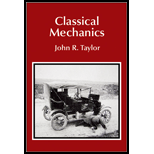
(a)
The Hamiltonian using generalized coordinates
(a)
Answer to Problem 13.21P
The Hamiltonian is
Explanation of Solution
Write the kinetic energy of the system
Here,
Write the potential energy of the system
Here,
The lagrangian of the spring – mass system is,
Write the center of mass position for rectangular coordinates,
Write the center of mass position for rectangular coordinates,
Substitute expression (III) and (IV) in equation (II) and solve for
Write the Canonical momenta along the
Write the Canonical momenta along the
Write the canonical velocity is,
Write the another canonical velocity is,
Conclusion:
Write the Hamiltonian of the system,
The Hamiltonian is
(b)
The
(b)
Answer to Problem 13.21P
The
Explanation of Solution
Write the Hamiltonian equation with respect to
Differentiate the equation on both sides,
Substitute
Conclusion:
Re-write the expression (II) by using binomial theorem to reduce the term
Write the fixed height of mass
Differentiate the equation on both the sides,
Similarly differentiate the equation on both the sides,
Substitute expression (III) in above expression (V),
Here, neglect the term
Therefore, the above result indicates that the
(c)
The angular frequency of the oscillations.
(c)
Answer to Problem 13.21P
The angular frequency of the oscillations
Explanation of Solution
Write the expression for
Write the relation between normal frequencies and
Write the frequency of the system is,
Conclusion:
Substitute
Substitute
The angular frequency of the oscillations
(d)
The value for
(d)
Answer to Problem 13.21P
The value for
Explanation of Solution
Write the expression for the angular frequency of the oscillations
Here, it is given that the angular frequency of the oscillation is equal to the orbital
Conclusion:
Therefore the angular frequency equation can be re-written as,
The value for
Want to see more full solutions like this?
Chapter 13 Solutions
Classical Mechanics
 College PhysicsPhysicsISBN:9781305952300Author:Raymond A. Serway, Chris VuillePublisher:Cengage Learning
College PhysicsPhysicsISBN:9781305952300Author:Raymond A. Serway, Chris VuillePublisher:Cengage Learning University Physics (14th Edition)PhysicsISBN:9780133969290Author:Hugh D. Young, Roger A. FreedmanPublisher:PEARSON
University Physics (14th Edition)PhysicsISBN:9780133969290Author:Hugh D. Young, Roger A. FreedmanPublisher:PEARSON Introduction To Quantum MechanicsPhysicsISBN:9781107189638Author:Griffiths, David J., Schroeter, Darrell F.Publisher:Cambridge University Press
Introduction To Quantum MechanicsPhysicsISBN:9781107189638Author:Griffiths, David J., Schroeter, Darrell F.Publisher:Cambridge University Press Physics for Scientists and EngineersPhysicsISBN:9781337553278Author:Raymond A. Serway, John W. JewettPublisher:Cengage Learning
Physics for Scientists and EngineersPhysicsISBN:9781337553278Author:Raymond A. Serway, John W. JewettPublisher:Cengage Learning Lecture- Tutorials for Introductory AstronomyPhysicsISBN:9780321820464Author:Edward E. Prather, Tim P. Slater, Jeff P. Adams, Gina BrissendenPublisher:Addison-Wesley
Lecture- Tutorials for Introductory AstronomyPhysicsISBN:9780321820464Author:Edward E. Prather, Tim P. Slater, Jeff P. Adams, Gina BrissendenPublisher:Addison-Wesley College Physics: A Strategic Approach (4th Editio...PhysicsISBN:9780134609034Author:Randall D. Knight (Professor Emeritus), Brian Jones, Stuart FieldPublisher:PEARSON
College Physics: A Strategic Approach (4th Editio...PhysicsISBN:9780134609034Author:Randall D. Knight (Professor Emeritus), Brian Jones, Stuart FieldPublisher:PEARSON





